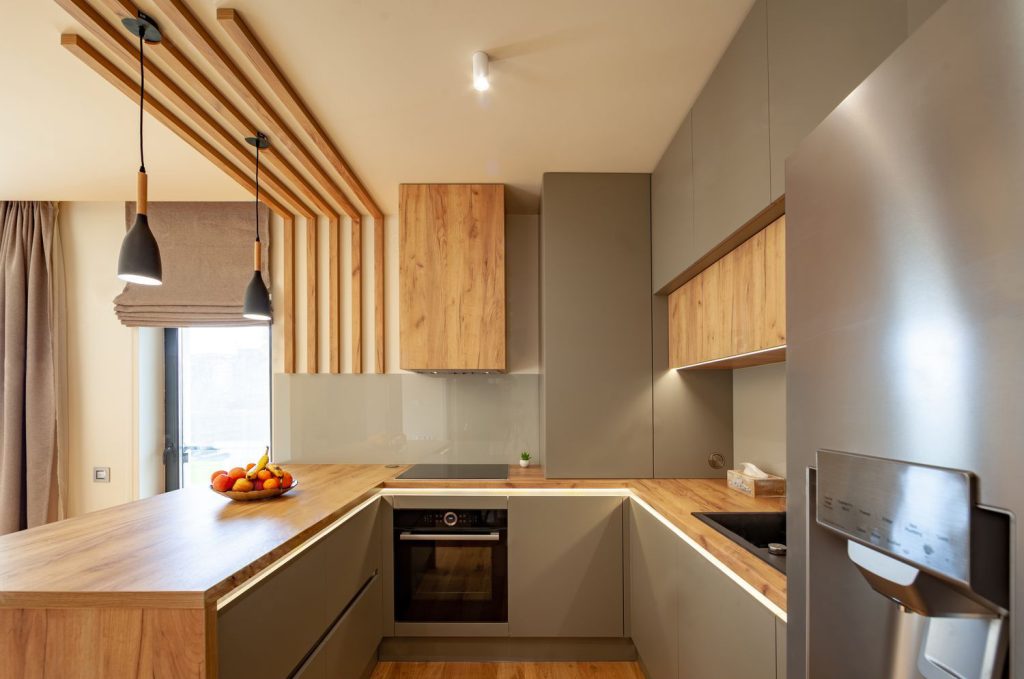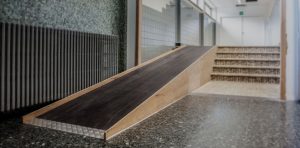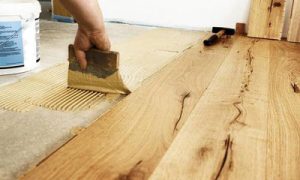Abstract: New environmentally friendly materials can also be called “green building materials.” This time, building materials can not only be recycled, but also protect the environment and humans themselves, making the environment more environmentally friendly and humans healthier. Interior decoration is a complex and tedious project, including the design of floors, walls, ceilings, and concealed engineering. Among these design contents, an important content is woodworking engineering. Since woodworking engineering requires the use of a large number of different types of boards, Therefore, the selection of panels has also become an important part of interior decoration. Based on this, this article mainly analyzes and discusses the environmental protection of interior decorative plywood panels.

As residents’ living standards continue to improve, their requirements for the living environment are also constantly increasing, especially in the pursuit of ecology, greenness, and environmental protection. Therefore, in the interior decoration industry, the use of healthy, environmentally friendly and pollution-free building decoration materials has become an inevitable trend in interior design and interior decoration material selection. With the introduction of the concept of “green building” and “green design”, the concept of ecological and environmentally friendly design has gradually become popular and has become an important consideration for owners when designing plans. Therefore, creating a comfortable, environmentally friendly and healthy indoor environment for owners has become an issue that the design industry needs to focus on.
Ⅰ. Analysis of characteristics of new environmentally friendly materials
New environmentally friendly materials can also be called “green building materials.” This time, building materials can not only be recycled, but also protect the environment and humans themselves, making the environment more environmentally friendly and humans healthier. New environmentally friendly materials have been widely used in building decoration construction abroad, and have also developed rapidly domestically. New environmentally friendly materials include antibacterial and deodorizing types and low-toxicity and low-emission types. Their main features are: (1) Green and healthy. The materials selected for the products are generally non-toxic, harmless and low-emission. Formaldehyde, halide solvents etc are not used in the production process, and do not contain pumps and other compounds, nor do they involve some heavy metals, such as lead, cadmium, etc. It is harmless to the human body and will not cause adverse effects on the environment. (2) Building materials products that greatly reduce building energy consumption. For example: new wall materials, it has benign functions such as light weight, high efficiency, thermal insulation, sound insulation and heat insulation. (3) Building materials that can make full use of industrial waste, such as cement materials that purify sewage and solidify toxic and harmful industrial waste, or cement component materials such as slag, fly ash, and silica fume that have been resourced and high-performance.
Ⅱ. The concept and related characteristics of ecological and environmentally friendly boards
1. The concept of ecological and environmentally friendly boards
As an important aspect of eco-environmental materials, there is currently no clear concept of eco-friendly boards. However, at present, most researchers have a consistent concept of eco-friendly boards, which is that they can be environmentally friendly during the production and use processes. It has the smallest impact on pollution and damage, and at the same time maximizes its function. It is a new type of environmentally friendly decorative board. It can be seen from this that ecological and environmentally friendly panels are a low-pollution or pollution-free healthy building material. At the same time, such panels can have good performance in terms of health and environmental protection of the residents. Based on this type of panels, Features, ecological and environmentally friendly boards are favored by most owners.
2. Characteristics of ecological and environmentally friendly boards
Due to the highly developed society today, people can learn about decorative materials in various ways. As ecological panels for interior decoration, they have the following characteristics:
(1) Minimize pollution and release of harmful gases. Most of the so-called ecological and environmentally friendly boards are materials with very low pollution levels and pollution indexes. Although there are some gas emissions, the pollution to the human body is basically non-existent. At the same time, in terms of indoor and outdoor environment and air quality assurance, they also comply with relevant regulations.
(2) It can effectively save resources and energy. The production and use of ecological and environmentally friendly boards can better ensure the needs of sustainable development. At the same time, in terms of production and manufacturing processes, they can better ensure that the environment will not cause pollution, and at the same time, the large amount of waste generated will be eliminated. Able to be recycled and reused in a reasonable manner.
(3) Use pollution-free and environmentally friendly materials in the production and manufacturing process. As we all know, most boards are polymeric or plywood. During the production and use of these boards, a large amount of glue and other related adhesives are inevitably used. For eco-friendly boards, it is necessary to ensure that formaldehyde and other related substances are not used during the production process. harmful compounds, thereby avoiding people’s concerns about the release of harmful gases from the board during use.
Ⅲ. Types of eco-friendly boards
In today’s use of interior decoration materials, a large number of ecological and environmentally friendly materials have been widely used. At the same time, a large number of manufacturers are constantly developing new material types to meet the needs of different customers. Currently, there are several types of eco-friendly boards in the market.
1. Original natural board
Such a board is a decorative board formed by cutting and processing pure natural tree species or wood (such as ash, pine, oak, etc). The main process of producing this board is cutting, pasting, and high-temperature baking, a decorative board formed by drying. This kind of decorative board uses less external materials and basically has original wooden texture and structure. It has a more natural appearance and a strong three-dimensional and realistic feeling. This kind of material has a lot of space in the current market, very popular with customers.
2.Eco-friendly plastic sheet
As a relatively new building material, ecological and environmentally friendly plastic sheets have the advantages of high temperature resistance and strong hardness. At the same time, they have good effects in fire prevention, sound insulation and other aspects. Most of the eco-friendly plastic boards are polyester materials. This material is characterized by its strong shape and rich color feeling. It is widely used in modern decorative materials, especially in the selection of boards for workwear. The characteristic of this type of board is that it is made of polymer materials during the production process, so its environmental protection and safety are better guaranteed.
3.Artificial formaldehyde-free wooden panels
The characteristic of artificial boards is that they imitate the grain and texture of natural wood. Due to mass production and processing, most of its textures are relatively regular and similar. At the same time, its three-dimensional and realistic feel are also significantly different from those of natural wood, but the advantage is that the price is relatively low, the maintenance during use is relatively simple, and it does not require very careful care and maintenance. Most of these synthetic materials are made by compressing wood chips, cardboard and other materials at high temperatures, and finally pasting them with glue. Therefore, it is inevitable that this type of board will release a certain amount of harmful gases such as formaldehyde. Based on such a situation, through research by some manufacturers, the artificial boards on the market now have relatively strict requirements in terms of formaldehyde emissions. Therefore, there are formaldehyde-free artificial boards currently on the market. The gas emissions of this type of boards comply with national regulations and requirements. For The human body and the indoor environment are also better protected, and it is also a best-selling product on the market.
Ⅳ. Analysis on the development prospects of new environmentally friendly materials
With the continuous advancement of science and technology and people’s increasing requirements for new environmentally friendly materials, in the future field, new environmentally friendly materials will focus on energy saving, environmental protection and non-toxicity.
(1) Develop water-based coatings to effectively reduce the content of organic volatile compounds.
(2) Use crystallized glass to replace traditional glass.
(3) Improve and innovate wood adhesives to eliminate formaldehyde content, with the goal of producing high-standard green and environmentally friendly wooden boards.
(4) Make full use of nanotechnology in the production process of nanomaterials.
(5) A series of new environmentally friendly materials, such as energy-saving walls, energy-saving glass curtain walls, energy-saving outer cladding materials, and energy-saving functional materials, have broad application prospects in future development. Among them, energy-saving walls can protect land resources, energy and the environment, and can also further improve the modernization level of building construction. In the future development process, this type of new environmentally friendly materials will comprehensively consider resources, energy, environment, construction and other aspects, and then develop new energy-saving walls that are timely and scientific, making the application of energy-saving walls more widespread.
Conclusion
Since decorative materials are closely related to our lives, they have become an important aspect of people’s lives. As an important part of interior decoration materials, boards have also attracted strong attention from designers and owners. Therefore, when selecting interior decoration panels, we should pay attention to not only meeting the functional requirements, but also considering the characteristics of the material itself, and ultimately meeting the requirements of ecology, environmental protection, and health. The ultimate goal of material selection is to create a more comfortable and environmentally friendly indoor environment. Therefore, ecologically friendly boards have also become the development trend in today’s interior decoration board selection. This kind of ecologically friendly boards is of great significance to interior decoration.


